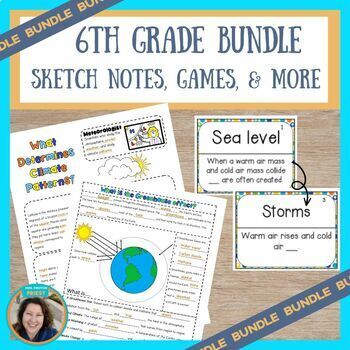6th Grade Science Bundle - Interactive Notebook Sketch Notes, Games, & More!
- Zip
- Easel Activity

Products in this Bundle (41)
showing 1-5 of 41 products
Bonus
Description
Save 20% by purchasing this NGSS 6th grade science bundle! Resources include 6th grade science sketch notes for interactive notebooks, quizzes, slideshows, CER writing, and some hands-on activities.
Included in this 6th grade science bundle:
Printable Science Sketch Notes
Air Mass MS ESS2-5 (notes, quiz, ppt)
Atmosphere and Water Cycle MS ESS2-5 (notes, quiz)
Convection in Air and Water MS ESS2-6 (notes, quiz, slideshow)
Crosscutting Concepts (notes, quiz, slideshow)
Diffusion and Osmosis (notes, activities, slideshow)
Environmental and Genetic Factors Influencing Growth MSS LS1-5 (notes, quiz, slideshow)
Genetic Variation MS LS3-2 (notes, quiz, slideshow)
Human Activities and Global Climate Change MS ESS3-5 (notes, quiz, slideshow, CER)
Human Body Systems MS LS1-3 (notes, quiz, slideshow)
Kinetic and Potential Energy MS PS3-1, MS PS3-5 (notes quiz, slideshow)
Organisms are Made of Cells (notes, quiz)
Prokaryotic and Eukaryotic Cells and Organelles MS LS1-2 (notes, quiz, slideshow, CER)
Sexual and Asexual Reproduction MS LS1-4 (notes, quiz, slideshow)
Thermal Energy Transfer MS PS3-4 (notes, quiz, slideshow)
What Determines Climate Patterns MS ESS2-6 (notes, quiz, slideshow)
Digital 6th Grade Science Notes
Genetic Variation MS LS3-2 (slides, CER, project, quiz)
Genetics: Sexual and Asexual Reproduction MS LS1-4 (slides, project)
Thermal Energy Transfer MS PS3-4 MS PS3-4 (slides, project, quiz)
Weather and Climate MS ESS2-6 (slides, project)
Prokaryotic and Eukaryotic Cells and Organelles MS LS1-2 (link is in sketch notes resource)
6th Grade Science Review Games
Atmosphere and Water Cycle
Cell Structure and Function
Convection Currents in Air and Water
Crosscutting Concepts
Earth and Human Impact
Genetic Variation
Human Activities and Global Climate Change
Human Body Systems
Microscope Parts and Cells
Plant and Animal Reproduction
What Determines Climate Patterns
6th Grade End of the Year Review
Concept Maps
Body Systems
Cell Structure and Function
Living Things are Made of Cells
Other Science Activities
Cell Membrane Activity and CER
Chemical Reaction Activity
Condor Conservation Quest
Engineering and Design Process Worksheet
Sexual and Asexual Poster Project
Bonus File
Flowchart for a suggested order for using the 6th grade science resources. This does not need to be followed but it can help you plan.
I LOVE MY FOLLOWERS!
Click on the green ★ to follow my store and get notifications about new resources and freebies!
Thank you for visiting my store! Happy Teaching!
Let's Connect!
Mrs. Proton Priest on Instagram
Mrs. Proton Priest on Facebook
Mrs. Proton Priest on Pinterest
WOULD YOU LIKE TO EARN FREE PRODUCTS?
To earn TPT credits to use on future purchases:
Go to your My Purchases page. Beside each purchase, you'll see a Provide Feedback button. Leave a rating and leave a short comment on the product. You can check your credit balance on your TpT Credit Balance page. Apply credits towards future TpT purchases in my store, or any TpT store. I value and appreciate your feedback!
****************************************************************************************
Copyright © Ginny Priest, Mrs. Proton Priest. All rights reserved by the author.





